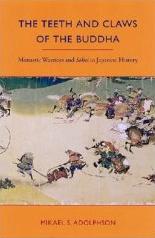THE TEETH AND CLAWS OF BUDDHISM: [[Monastic Warriors and Sohei in Japanese History, by Mikael S. Adolphson. Honolulu: University of Hawai’i Press, 2007, 214 pp., with 32 illustrations and maps, $ 36 (cloth)]]
 Buddha with fangs and claws is an unexpected image, if only because religions so often express themselves as benign. Actually, however, they are also belligerent and can often be detected flexing their muscles. Among such examples are Japan’s monastic warriors, Buddha’s soldiers, fighting their way through the Heian (794-1185) and Kamakura (1185-1333) periods.
Buddha with fangs and claws is an unexpected image, if only because religions so often express themselves as benign. Actually, however, they are also belligerent and can often be detected flexing their muscles. Among such examples are Japan’s monastic warriors, Buddha’s soldiers, fighting their way through the Heian (794-1185) and Kamakura (1185-1333) periods.
We see them in many an early text and scroll. In “The Heike Story” they descend from their heights on Mount. Hiei and fall upon Kiyomizu temple below, and we hear the Emperor Go-Shirakawa’s lament that the three things beyond his control are the Kamo River, the roll of the dice, and “the mountain clerics.”
Their ferocity was often such that, in the words of the author of this interestingly deconstructive study of these military groups: “One might even argue that religious beliefs have as often been used to condone violence as to condemn it.”
Indeed, he continues: “Buddhism in Japan seems no different from Christianity in Europe . . . or Islam in Minor Asia, neither do Japanese monastic warriors appear any different from European crusaders or Spanish Moors.”
This is the import of his argument — that the military monks were soldiers, just as were the samurai, but that their true role has been obscured and in some part constructed.
There are reasons for this. Among these is the modern notion that religion and politics should be separate, though this was by no means the case in earlier ages. At the same time there is the notion that Buddhism was going through a degenerate age during which it failed to rein in the bellicose.
Among the results is that those who armed themselves and fought in the name of temples must be relegated to historical obscurity. Sources have been lost or are rarely consulted, and scholars and historians have made a number of sweeping generalizations, concerning just who these “holy” samurai were. As though to conceal a lack of knowledge, a neologism was fabricated in the 14th century and the temple roughneck was subsumed into the image of the sohei, the holy warrior.
“In short,” says the author, “the view of monastic warriors as something fundamentally different from other warriors is based more on the constructs of the observer than on the societal circumstances in which those figures actually lived.”
An example, fully outlined in the text, is the most famous of the sohei, the military warrior Saito Musashibo Benkei (1155-1189). It was he who taught the young Minamoto no Yoshitsune (1159-1189) how to use his sword. He then followed Yoshitsune in battle after battle. His exemplary devotion has won him high popular regard and he lives on in a variety of products, including brands of sake, Benkei dolls, manga, and the names of pachinko parlors.
He is, at the same time, a construct, molded by the social pressures of later generations. Not only are the sohei to be denigrated as “evil” monks and used by politicians right up to the Meiji Era (1857-1912), but one of their number is to be rehabilitated by his display of military loyalty. It is perhaps this double standard that has ensured Benkei’s useful popularity.
Interesting as this account is, it will mostly appeal to other scholars (who will doubtless be more attentive after having read it) and to students of history. Students of criticism, among whom I number myself, will find its major interest to be in its demonstration of the techniques of deconstruction — a critique of those concepts and hierarchies that are essential to traditional criteria but which, nevertheless, achieve their status only by repressing other elements that are then “forgotten.”
In giving us this class act demonstration of the deconstructive theories of Jacques Derrida et al., Mikael Adolphson here offers a picture of the destruction of the Buddhist mercenaries, the erection of the white-washed sohei, and the rise of a purely cardboard Benkei.
By Donald Richie
Source : The Japan Times




